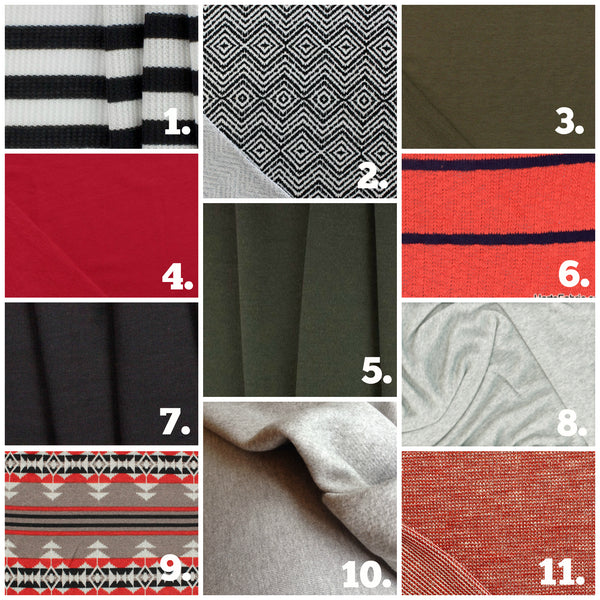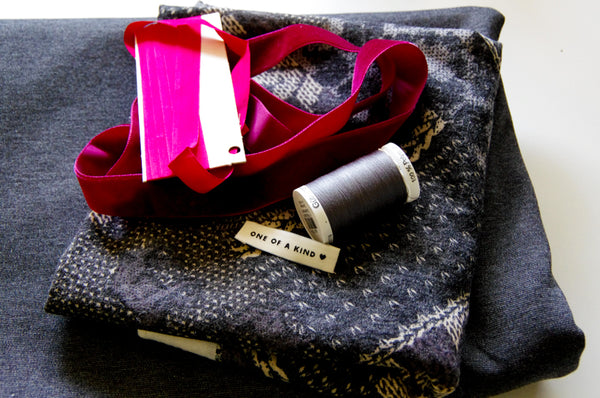Finlayson Sweater Sew-Along: Day 1 - Choosing your fabric and supplies
Let's go fabric shopping!
Welcome to the Finlayson Sweater Sew-Along! Today we will be discussing fabric and notion choices. The Finlayson Sweater is a very flexible pattern - it will sew up nicely in just about any knit! It looks great as a light summer sweater in knits with hardly any body (for example, a cotton rib knit) and it looks entirely different but just as awesome in a thick and cozy sweatshirt fleece.
To choose your fabric, you will only need to keep a few simple guidelines in mind:
Warmth: The Finlayson looks equally nice in a classic sweatshirt fleece (with a smooth right side and fuzzy wrong side) or in a thin waffle or ribbed knit. A thicker, warmer Finlayson is perfect to wear over a t-shirt with jeans while a thin Finlayson would be really stylish worn under a blazer with slim-fit Jedediah pants!
Drape: Very drapey knits look lovely with the Finlayson but keep in mind that most men are not used to wearing drapey fabrics and that slinky knits tend to look a little feminine...so choose how drapey your fabric will be based on who you are sewing your Finlayson for!
Thickness (for your sewing machine): The Finlayson cannot be made with heavy-weight knits because the overlapped collar creates quite a few layers to sew through at center front. Domestic machines can easily handle these layers when sewing through a light or medium weight knit but might struggle with a super thick fleece!
Stretch: The Finlayson body is quite loose and boxy and the neckline is wide enough to fit over the head even if the fabric you choose has very little stretch. The only areas of the Finlayson Sweater that require a bit of extra stretch are the cuffs and the hem band. This is because they are drafted considerably smaller than the body of the garment to create a tighter fit in these areas. If your fabric doesn't have much stretch it can be a little more difficult to ease in the excess fabric when sewing the bands to the garment. Not to worry though! We've included a second longer cuff piece that will be easier to sew in more stable knits! Or...you could choose a contrast stretchy rib knit for the cuff and hem bands as is often seen on store bought hoodies (good luck finding a matching color though!).
If you can't find any suitable fabric at your local fabric shop, there are plenty of options online!

- Striped Black & White Cotton Blend Waffle Knit - Britex Fabrics
- Black Ethnic Diamond Baby French Terry Knit Fabric - Girl Charlee
- Sandalwood Cotton Modal Lycra French Terry Knit Fabric - Girl Charlee
- Rose Red Cotton Jersey Sweatshirt Fleece Knit Fabric - Girl Charlee
- Mid-weight Drapey Loden Green Wool Knit - Britex Fabrics
- Summer Sweater Knit Red - Harts Fabric
- Midweight Black Cotton Fleece Knit - Britex Fabrics
- Terry Backed Sweatshirt Grey - Harts Fabric
- Navajo Indian Blanket Red Mushroom Hacci Sweater Knit Fabric - Girl Charlee
- Organic Bamboo Charcoal Fleece - Simplifi Fabric
- Red Heather Sparkle Hacci Sweater Knit Fabric - Girl Charlee

And now let's talk notions
Since there are no tricky closures on the Finlayson, there aren't many necessary notions. All the same, I've got a few ideas and tricks up my sleeve to create a really professional and high-end hoodie or sweater, so if you prefer to take the extra sewing time, you can jazz up your hoodie with trims and stabilizers to your heart's content!
Within the instruction booklet I've included options for finishing the neckline and the kangaroo pocket openings with twill tape. Aside from twill tape, you can use all sorts of decorative trims to finish these areas. For the neckline it is best to use something with considerable flexibility because the trim has to fit to the slight curve of the neckline. Consider twill tape as recommended, cotton lace (soft and supple), or, hem tape or bias binding. For the kangaroo pocket you can use just about anything because the curve of the pocket opening is so very slight. Try any sort of ribbon or trim you would like! Here are the ones I've collected for my sweaters (I went a little over-board choosing these...I obviously won't be able to use them all :P).

To stabilize the shoulder seams (always a good idea when sewing knit garments so they don't stretch out and sag after a day of wear), you can use any of the following options:

I like using strips of lining or selvages because I always have them on hand and they're free! Make sure to choose a thin fabric so you don't add too much bulk to your shoulder seams.
My second favorite choice is clear swimwear elastic. It is a little slipper to handle when sewing but it is very strong and resilient. I also like to add this elastic to all the horizontal seams - such as the cuffs and hem band. That way these seams won't stretch out when the sweater is being put on and taken off!
A pretty option for stabilizing the shoulders is to use rayon hem tape. I find vintage packages of these at almost every thrift store I go to and they are so cheap! These tapes are very stable and very thin and you can find them in almost any color you need.
Have fun choosing your fabric and notions! Please ask away if you are unsure of what to choose. I'll leave you now with my favorite fabric shopping tip: When in doubt about what type of fabric to choose, simply open up your closet or head to a thrift store/clothing store and examine garments that are similar to the pattern you are working with. If you like how cozy your Lululemon hoodie is, for example, have a look at the care tag and jot down the fiber content. Make a note of the fabric's thickness and texture. Or simply bring the garment to the fabric store and compare the fabric's stretch and drape with your potential choices right on the bolt!

